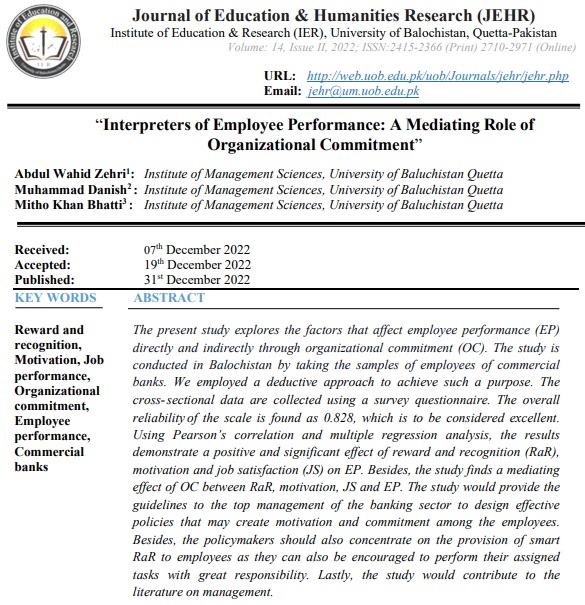Interpreters of employee performance: A mediating role of organizational commitment
Abstract
The present study explores the factors that affect employee performance (EP) directly and indirectly through organizational commitment (OC). The study is conducted in Balochistan by taking the samples of employees of commercial banks. We employed a deductive approach to achieve such a purpose. The cross- sectional data are collected using a survey questionnaire. The overall reliability of the scale is found as 0.828, which is to be considered excellent. Using Pearson’s correlation and multiple regression analysis, the results demonstrate a positive and significant effect of reward and recognition (RaR), motivation and job satisfaction (JS) on EP. Besides, the study finds a mediating effect of OC between RaR, motivation, JS and EP. The study would provide the guidelines to the top management of the banking sector to design effective policies that may create motivation and commitment among the employees. Besides, the policymakers should also concentrate on the provision of smart RaR to employees as they can also be encouraged to perform their assigned tasks with great responsibility. Lastly, the study would contribute to the literature on management.
KEYWORDS: Reward and recognition, Motivation, Job performance, Organizational commitment, Employee performance, Commercial banks
References
Affandie, A.A., Sulistiyono, A., Mayasari, D., Suyono, J., & Elisabeth, D.R. (2020). The mediating role of organizational commitment in relationship between organizational communications on knowledge sharing. Proceedings of the 2nd African International Conference on Industrial Engineering and Operations Management, Harare, Zimbabwe, December 7-10, 2020
Ali, A., Li Bin, L.Z., Piang, H. J., & Ali, Z. (2016). The impact of motivation on the employee performance and job satisfaction in IT park (Software House) sector of Peshawar, Pakistan. International Journal of Academic Research in Business and Social Sciences, 6(9), 297-310.
Al-Madi, F. N., Assa, H., Shrafat, F., & Zeglat, D. (2017). The impact of employee motivation on organizational commitment. European Journal of Business and Management, 9(15), 134- 145.
Bakotić, D. (2016). Relationship between job satisfaction and organizational performance. Economic Research- Ekonomska Istraživanja, 29(1), 118- 130.
Bao, C., & Nizam, I. (2015). The impact of motivation on employee performance in the electronics industry in China. International Journal of Accounting & Business Management, 3(2), 29-45.
Baqir, M., Hussain, S., Waseem, R., & Islam, K.M.A. (2020). Impact of reward and recognition, supervisor support on employee engagement. American International Journal of Business and Management studies, 2(3), https://doi.org/10.46545/aijbms.v2i3.256
Bhatti, M.K., Soomro, B.A., & Shah, N. (2021b). Training characteristics and employees' performance among the nurses in Pakistan. Journal of Economic and Administrative Sciences, https://doi.org/10.1108/JEAS-02-2021-0026
Bhatti, M.K., Soomro, B.A., & Shah, N. (2021a). Predictive power of training design on employee performance: an empirical approach in Pakistan's health sector. International Journal of Productivity and Performance Management, https://doi.org/10.1108/IJPPM-09-2020-0489
Danish, R. Q., & Usman, A. (2010). Impact of reward and recognition on job satisfaction and motivation: An empirical study from Pakistan. International Journal of Business and Management, 5(2), 159-167.
Doyle, A. (2010). Types of employee benefits: List of government mandated and employer provided employee benefits (2010). Retrieved October 6, 2019 fromhttp://jobsearch.about.com/od/employeebenefi ts/a/typesofemployeebenefits.htm
Duorojaiye, M.O.A. (2002). A new introduction to educational psychology, Evans brothers Ltd, employee engagement. Procedia-Social and Behavioral Sciences, 40, 498-508.
Gale, C. (2002). Encyclopedia of small business: Employee reward and recognition systems (2002). Retrieved on October 6, 2019 from http://www. answers.com/topic/employee- reward-and-recognition-systems.
Ghina, A. (2012). The influence of corporate culture on organizational commitment; Case study of civil government organizations in Indonesia. International Journal of Basic and Applied Science, 01 ( 02), pp. 156-170.
Hult, G.T.M.D.J.K. Jr, Griffith, D.A., Chabowski, B.R., Hamman, M.K., Dykes, B.J., Pollitte, W.A., &Cavusgil, S.T. (2008). An assessment of the measurement of performance in international business research. Journal of International Business Studies, 39(6), 1064-1080.
Hussain, S. D., Nisar, Q. A.,Kamboh, A. Z., & Ali, S. (2019). Impact of employees’ recognition, rewards and job stress on job performance: Mediating role of perceived organization support. SEISENSE Journal of Management, 10(10), 25-37.
Inayat, W., & Khan, M.J. (2021). A study of job satisfaction and its effect on the performance of employees working in private sector organizations, Peshawar. Education Research International, 2021, Article ID 1751495, pp.1-9.
Jameel A. S. (2022). The mediating role of organizational commitment between organizational culture and job performance in the telecommunication sector. Management & Economics Research Journal, 4(1), 81-100.
Kankisingi, G.M., & Dhliwayo, S. (2022). Rewards and innovation performance in manufacturing small and medium enterprises (SMEs). Sustainability, 14(3), 1-19.
Labetubun, M. R., & Dewi, I. G. A. M. (2022). Organizational commitment: It’s Mediating role in the effect of human resource management practices and workplace spirituality on employee performance. European Journal of Business and Management Research, 7(2), 112–123.
La-Motta, T. (1995). Recognition: The quality way: quality resources. New York.
Manas, T. M., & Graham, M. D. (2003). Creating a total rewards strategy: A toolkit for designing business-based plans. AMACOM/American Management Association.
Markova, G., & Ford, C. (2011). Is money the panacea? Rewards for knowledge workers.
International Journal of Productivity and Performance Management, 60(8), 813-823.
Moorhead, G., &Griffin, R.W. (1998). Organizational behavior: Managing people and organizations. 5th ed., Houghton Mifflin, Boston, MA.
Morris C. G. (2006). Psychology an Introduction. Prentice Hall, Englewood Cliffs.
Okta, K., Umar, N., Musadiq, A., Utami, N., & Hamidah, N.U. (2015). The influence of organizational culture and entrepreneurial orientation on the job satisfaction, organizational commitment, and employee’s performance. European Journal of Business and Management, 7(2), 55-67.
Pahos N and Galanaki E (2022) Performance Effects of High Performance Work Systems on Committed, Long-Term Employees: A Multilevel Study. Frontiers in Psychology, 13, 825397.
Pruden, L (2012). Reward and recognition. Retrieved October, 26, 2019 from http://edweb. sdsu.edu/people/arossett/pie/Interventions/incentivesrewards_1.htm 37.
Şentürk, F.K., & Ertem, M. (2021). The mediating role of organizational commitment in the effect of perception of commitment to change on job satisfaction. Journal of Business Research-Turk, 13 (1), 760-771.
Shmailan, A.S.B. (2016). The relationship between job satisfaction, job performance and employee engagement: An explorative study. Issues in Business Management and Economics, 4 (1), 1-8.
Silva, S. (2009). Motivation theories- Understanding the content theories of motivation. Retrieved October 23, 2019,




